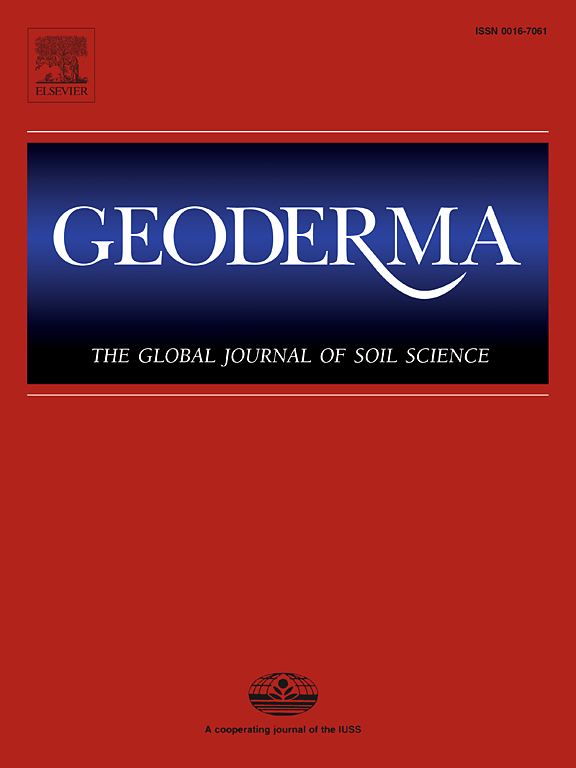Cropping system is a key determinant of soil health after accounting for environmental and edaphic variability
IF 5.6
1区 农林科学
Q1 SOIL SCIENCE
引用次数: 0
Abstract
Soil health assessment is critical for understanding and promoting sustainable soil management practices. Soil health assessment methods incorporate a variety of inherent environmental and edaphic properties, including climate variables and texture, as well as cropping system. However, these inherent properties often vary systematically among cropping systems and potentially confound the effects of cropping system on soil health. Using a new soil health dataset in Florida, we adopted propensity score weighting to model each sample’s probability of belonging to a particular cropping system based on soil drainage class, clay content, mean annual temperature (MAT), and mean annual precipitation (MAP). By balancing these factors across systems, this method enabled unbiased estimation of cropping system effects. The effects of cropping system on soil health indicators remained statistically meaningful after propensity score weighting using the same significance threshold (α = 0.05). Soil organic matter and carbon-related indicators were consistently higher in grazed pastures than in row crop systems, indicating that differences in disturbance and management intensity across cropping systems regulated soil health. Similarly, soil pH and phosphorus saturation ratio (PSR) were higher in row crop systems than in grazed pastures, which likely reflected the differences in chemical inputs among these systems. In contrast, our results showed that before propensity score weighting, Mehlich-3 extractable nutrients were higher in row crops than in hayfields and grazed pastures; however, these effects became non-significant after weighting, suggesting that they were partially driven by differences in inherent properties among cropping systems. Variance partition analysis further confirmed cropping system as a consistent driver of the carbon-based indicators, while the impacts of inherent properties were indicator-specific. Overall, our results demonstrate the importance of considering variability in inherent properties when evaluating cropping system impacts on soil health. Propensity score weighting offers a robust approach for addressing complex interactions among soil health drivers.
考虑到环境和土壤变异,种植制度是土壤健康的关键决定因素
土壤健康评价对于理解和促进可持续土壤管理实践至关重要。土壤健康评价方法包括各种固有的环境和土壤特性,包括气候变量和质地,以及种植制度。然而,这些固有特性往往在不同的种植制度之间系统性地变化,并可能混淆种植制度对土壤健康的影响。利用佛罗里达州一个新的土壤健康数据集,我们采用倾向得分加权法,基于土壤排水等级、粘土含量、年平均温度(MAT)和年平均降水(MAP),对每个样本属于特定种植系统的概率进行建模。通过平衡系统间的这些因素,该方法能够对种植系统的影响进行无偏估计。采用相同显著性阈值加权倾向性得分后,不同种植制度对土壤健康指标的影响仍具有统计学意义(α = 0.05)。放牧草地土壤有机质和碳相关指标始终高于行作系统,表明不同种植系统间干扰和管理强度的差异调节着土壤健康。同样,土壤pH和磷饱和比(PSR)在行耕系统中高于放牧系统,这可能反映了这些系统之间化学投入的差异。结果表明,在倾向得分加权前,行作作物的Mehlich-3可提取养分含量高于干地和放牧;然而,这些影响在加权后变得不显著,这表明它们部分是由种植制度之间固有特性的差异驱动的。方差划分分析进一步证实了种植制度对碳基指标的影响是一致的,而固有属性的影响是指标特异性的。总的来说,我们的研究结果表明,在评估种植制度对土壤健康的影响时,考虑内在特性的变异性是很重要的。倾向得分加权为解决土壤健康驱动因素之间复杂的相互作用提供了一种强有力的方法。
本文章由计算机程序翻译,如有差异,请以英文原文为准。
求助全文
约1分钟内获得全文
求助全文
来源期刊

Geoderma
农林科学-土壤科学
CiteScore
11.80
自引率
6.60%
发文量
597
审稿时长
58 days
期刊介绍:
Geoderma - the global journal of soil science - welcomes authors, readers and soil research from all parts of the world, encourages worldwide soil studies, and embraces all aspects of soil science and its associated pedagogy. The journal particularly welcomes interdisciplinary work focusing on dynamic soil processes and functions across space and time.
 求助内容:
求助内容: 应助结果提醒方式:
应助结果提醒方式:


